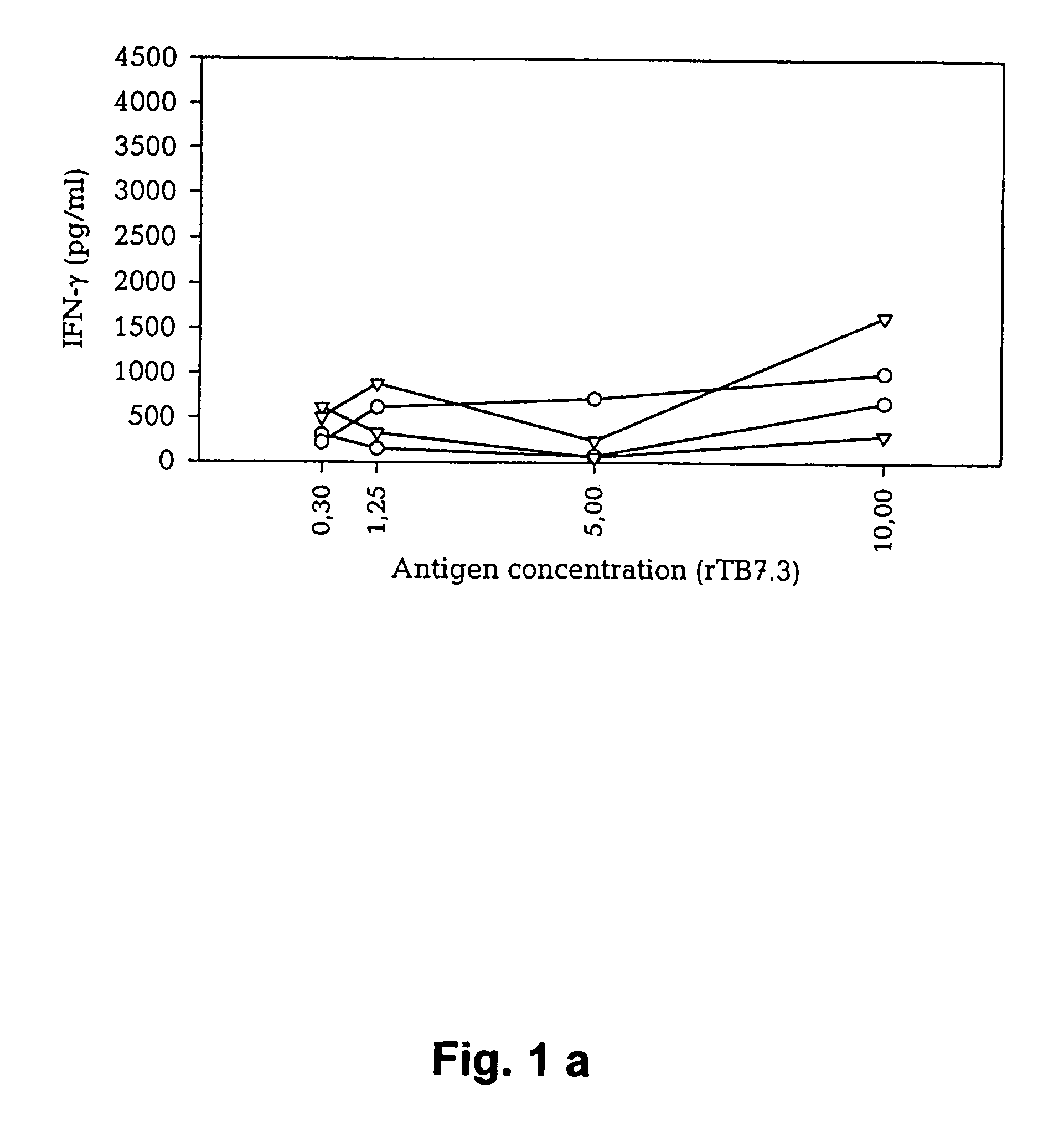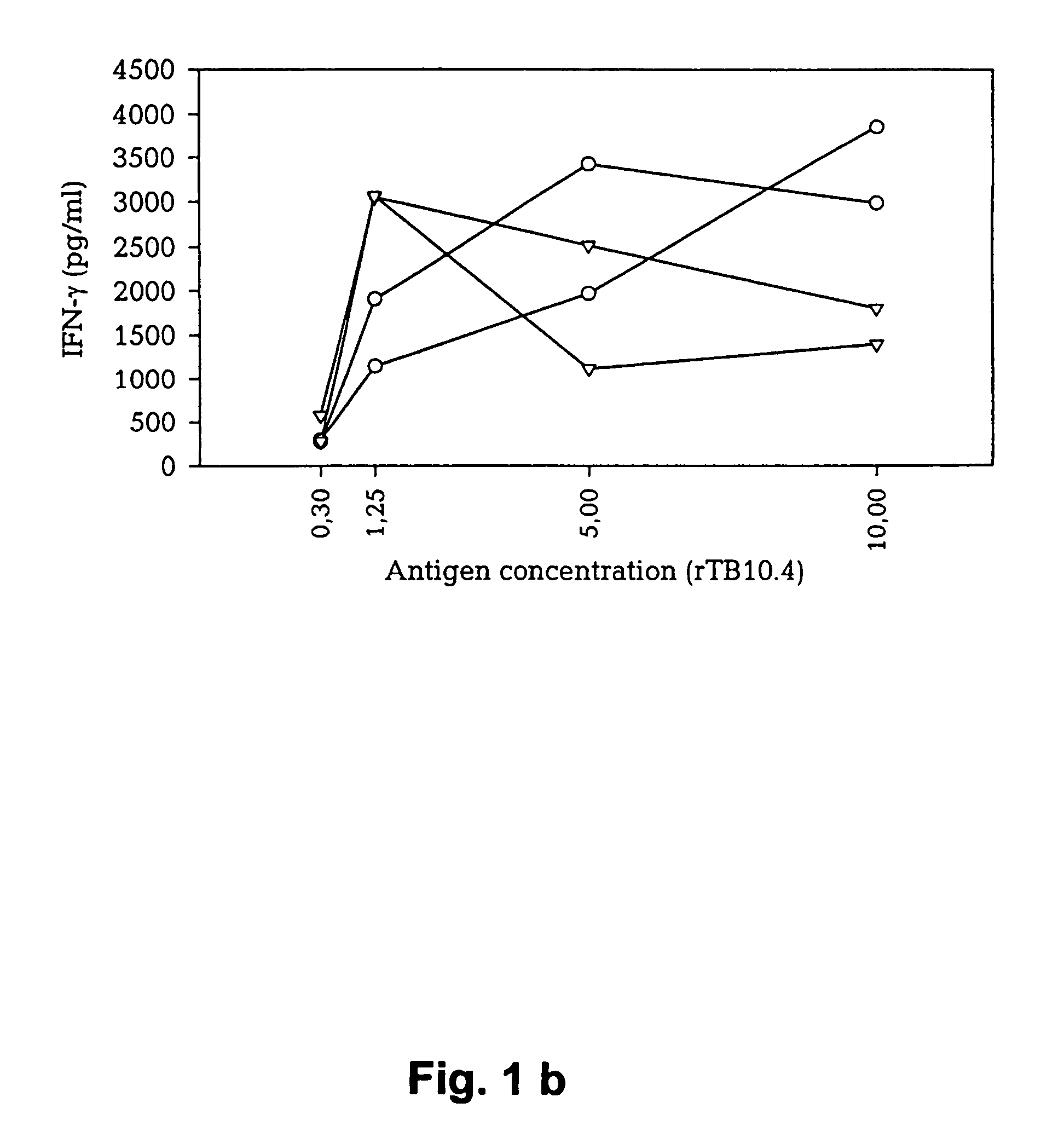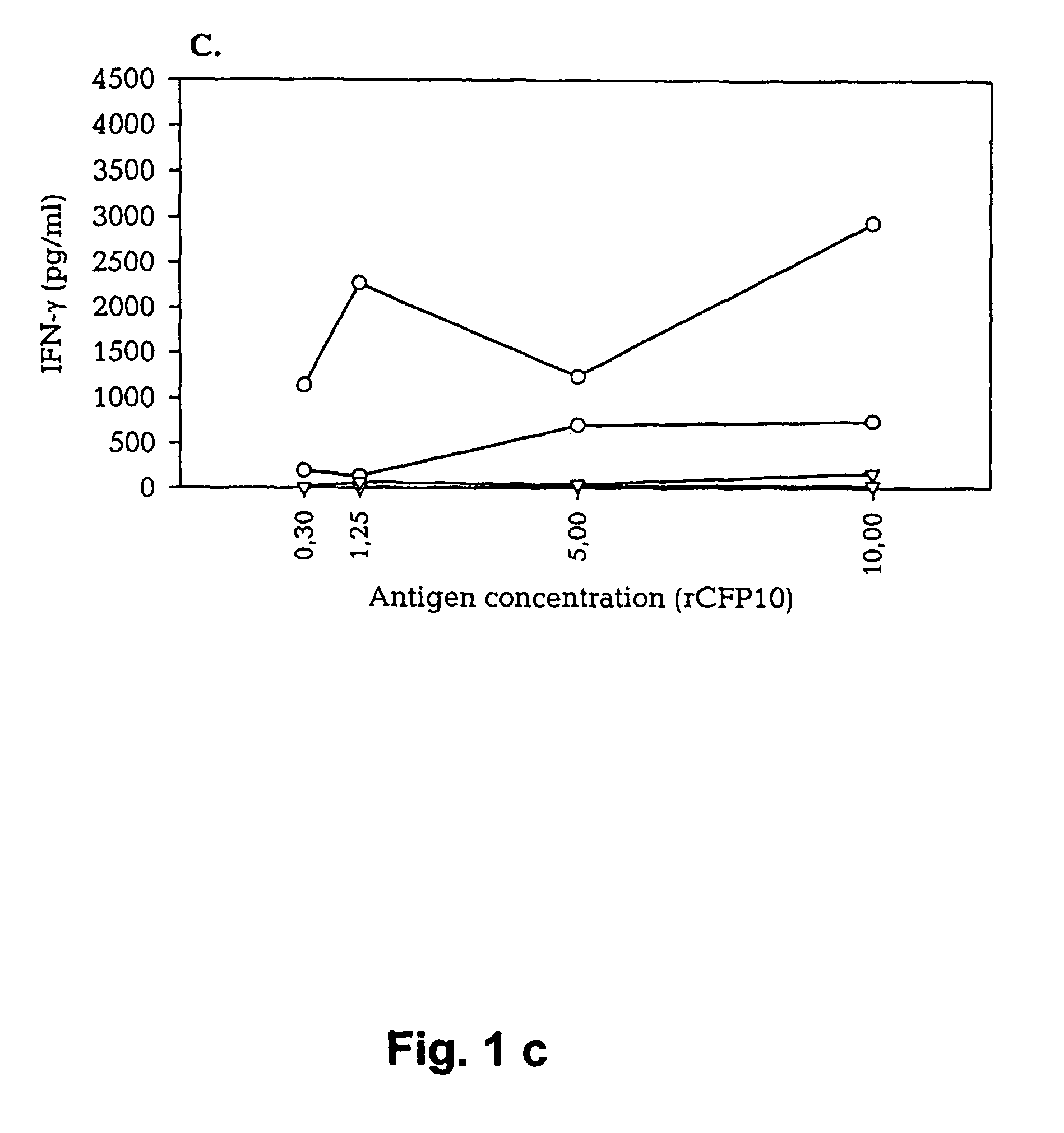Tuberculosis vaccine and diagnostics based on the Mycobacterium tuberculosis sat-6 gene family
a technology of mycobacterium tuberculosis and vaccine, applied in the field of vaccine and diagnostics based on the mycobacterium tuberculosis sat6 gene family, can solve the problems of low immunogenicity, high cost and labor intensity of current diagnostic assays for determining m. tuberculosis infection, and achieve enhanced immunogenicity and the presentation of relevant antigens such as those of the present invention.
- Summary
- Abstract
- Description
- Claims
- Application Information
AI Technical Summary
Benefits of technology
Problems solved by technology
Method used
Image
Examples
example 1
The Effect of CFP10, ESAT-6, and TB10.4 on Stimulation of PBMC's From Human TB Patients
[0165]The ESAT-6 antigen was identified in the low molecular mass fraction of culture filtrate due to a strong T cell response with high levels of IFN-γ released (Andersen et al 1995). This antigen has now in a number of studies been demonstrated to have good stimulatory antigenic properties and is recognized strongly by a high percentage of TB patients as well as different animal species infected with TB. Recently, a few other small proteins have been identified from various mycobacterial extracts and evaluated for their immunological relevance. Recently, a 10 kDa molecule (CFP10) encoded in the same operon as ESAT-6 was identified (Berthet, F. X. 1998).
[0166]Two novel low mass M. tuberculosis proteins have been identified: TB10.4, and TB7.3 (identical to Rv3221c and not a member of the ESAT-6 gene family). TB10.4 was identified as a novel member of the ESAT-6 family and our data demonstrate that...
example 2
Cloning of the Genes Encoding Low Mass Proteins from the ESAT-6 Family
[0177]The genes encoding Rv0287, Rv1036c, Rv1037c, Rv2346c, Rv2348c, Rv2653c, Rv2654c, Rv3020c, Rv3444c, Rv3445c, Rv3890c, Rv3891c, Rv3904c and Rv3905c were cloned into the expression vector pMCT3 (identical to pMCT6, Harboe et al, 1998, except that it only contains six N-terminal histidine residues), by PCR amplification with gene specific primers, for recombinant expression in E. coli of the proteins.
[0178]For cloning of the proteins, the following gene specific primers were used:
[0179]Rv0287:
[0180]
PA0287:5′-CTGAGATCTATGAGCCTTTTGGATGC-3′ (Bg / II) (SEQ ID NO: 32)PB0287:5′-CTAAGCTTGGATCCTCAGAACCCGGTATAGG-3′(BamHI) (SEQ ID NO: 33)Rvl036c: PA1036c:5-CTGAGATCTTTGATCCCCGGTCGGATGGTG (Bg / II). (SEQ ID NO: 34)PB1036c:5′-CTCCCATGGGTCAGGTGATCGAATCAGCCA (NcoI) (SEQ ID NO: 35)Rvl037c:PA1037c:5′-CTGAGATCTATGACCATCAACTATC-3′ (Bg / II)(SEQ ID NO: 36PB1037c:5′-CTAAGCTTGGATCCTTAGGCCCAGCTGGAGCC-3′ (BamHI) (SEQ ID NO: 37)Rv2346c:PA2346...
example 3a
Interferon-γ Induction of T Cell Lines
[0216]The purified recombinant proteins were screened for the ability to induce a T cell response measured as IFN-γ release. The screening involved testing of the IFN-γ induction of T cell lines generated from PPD positive donors and / or a measurement of the response in PBMC preparations obtained from TB patients, PPD positive as well as negative healthy donors.
[0217]Human donors: PBMC were obtained from healthy donors with a positive in vitro response to PPD.
[0218]T cell line preparation: T cell lines were prepared by culturing 1-5×106 freshly isolated PBMC with viable M. tuberculosis for 1½ hour at a ratio of 5 bacteria per cell in a total volume of 1 ml (Donor 1 and 2). After washing, the cells were cultured in RPM' 1640 medium (Gibco, Grand Island, N.Y) supplemented with HEPES, and 10% heat-inactivated NHS. Alternatively, T cell lines were prepared by culturing 1-5×106 freshly isolated PBMC with 5 μg / ml of ST-CF (Donor 3-5). After 7 days in c...
PUM
| Property | Measurement | Unit |
|---|---|---|
| pH | aaaaa | aaaaa |
| concentration | aaaaa | aaaaa |
| concentration | aaaaa | aaaaa |
Abstract
Description
Claims
Application Information
 Login to View More
Login to View More - R&D
- Intellectual Property
- Life Sciences
- Materials
- Tech Scout
- Unparalleled Data Quality
- Higher Quality Content
- 60% Fewer Hallucinations
Browse by: Latest US Patents, China's latest patents, Technical Efficacy Thesaurus, Application Domain, Technology Topic, Popular Technical Reports.
© 2025 PatSnap. All rights reserved.Legal|Privacy policy|Modern Slavery Act Transparency Statement|Sitemap|About US| Contact US: help@patsnap.com



